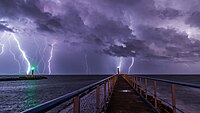
Photo from wikipedia
To understand the climatology of lightning affecting Britain and Ireland and to investigate the large‐scale environments which produce lightning in this region, relationships between mean sea‐level pressure (MSLP) patterns and… Click to show full abstract
To understand the climatology of lightning affecting Britain and Ireland and to investigate the large‐scale environments which produce lightning in this region, relationships between mean sea‐level pressure (MSLP) patterns and thunderstorm occurrence are investigated. Using daily data between 2010 and 2019, instances of lightning activity are examined against a set of 30 pre‐defined weather patterns based on MSLP. Metrics relating to thunder area, thunder intensity and duration are introduced and evaluated on the data set. The results show that in summer the largest and long‐lived lightning outbreaks can be linked to three weather patterns. Two of these have strong southerly flow affecting the domain of study. The third is a low‐pressure system centred over the UK with weak pressure gradient, which also produces larger lightning outbreaks during the autumn. In the wintertime, lightning outbreaks appear associated with deeper low‐pressure systems, higher pressure gradients and strong winds in four dominant weather patterns. In spring, lightning occurs mostly in smaller systems and can be of multiple weather patterns. It is hypothesised that the weather pattern number is a good predictor of atmospheric instability. Cases where lightning activity does not match the expected behaviour for a given weather pattern are thought to be due to anomalies or variation in atmospheric instability. Several applications of this work are also discussed, including looking at thunder days over the study domain in past and future climate scenarios.
Journal Title: Quarterly Journal of the Royal Meteorological Society
Year Published: 2021
Link to full text (if available)
Share on Social Media: Sign Up to like & get
recommendations!